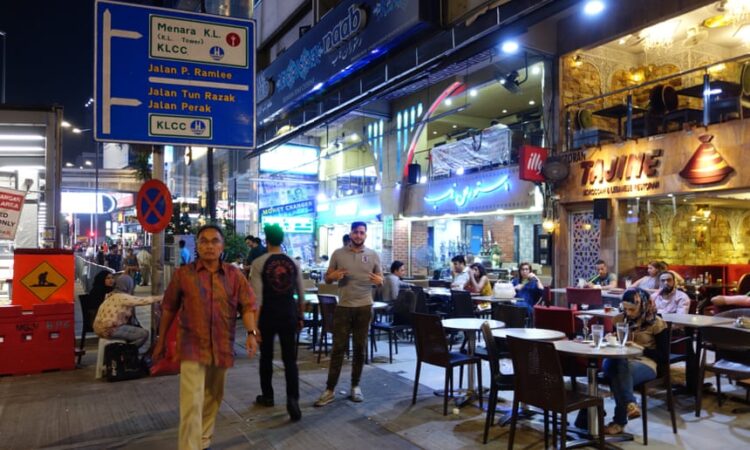KUALA LUMPUR: A little patch of grass sits between international banks and flashy skyscrapers in downtown Kuala Lumpur. There’s a big statue of a water jug, and some gold and red ramadas (gazebos) meant to recall traditional Moroccan architecture. On the edge of the park are kebab stands and a small mall. The gate at the entrance reads Ain Arabia.
Like many purpose-built tourist attractions, this Arab-themed urban village in Malaysia’s capital is a bit hokey, and given the searing sun, few people mill around for long. But when it was built in 2005, the “Eye of Arabia” was a small gesture to Middle Eastern and Muslim travellers – that whatever other countries might think of Muslims, they were welcome in Kuala Lumpur.
Twelve years later, that message has paid off. Though it’s only 60% Muslim, Malaysia now ranks first on a global list of Muslim-friendly tourist destinations. While other countries made life difficult for them, Malaysia has specifically courted Muslim travellers with small tweaks, such as making halal food and prayer rooms readily available and clearly marked. The government’s dedicated Islamic Tourism Centre says the country of 30 million now receives about 5 million Muslim tourists a year.
“After 9/11, it became difficult for many Muslims, especially from the Middle East, to travel to many traditional tourist destinations like Europe and the US,” says Fazal Bahardeen, founder of Crescent Rating, the travel company behind the ranking. “Malaysia was one of the first countries to realise the potential of this market.”
It’s often simple things that create a Muslim-friendly environment, he says. “A common misconception is that ‘Muslim tourism’ means people going to do Muslim things. But in reality, they go to do the same things – they may want a shopping experience, or a beach experience, or a local cultural experience. They want to have fun like anyone else, but they just want to know they don’t have to worry about their basic faith-based needs.”
The influx of Muslim tourists has transformed parts of Kuala Lumpur. Ain Arabia now feels almost humble compared to the much larger and more lucrative businesses catering to Muslim tourists. The main strip on Bukit Bintang street offers almost entirely Arab and Middle Eastern food; and there are designer fashion boutiques, luxury hotels and the Pavilion Mall, where families from Saudi Arabia, the United Arab Emirates and many other countries spend hours shopping.
“I personally deal with the Arabic speakers, but there are also Iranians, and Muslim tourists from everywhere,” says Nagmaldeen Amer, a 25-year old Yemeni who fled war and found a job in the Ain Arabia mall selling travel packages to islands or theme parks outside Kuala Lumpur.
Next to Amer’s stall is a Bangladeshi barber, Prodip Chandra, who specialises in curly hair and beards. “Malaysians don’t really ever wear beards,” Amer laughs. “Here, that’s a special skill.”
Tourism is vital to most south-east Asian countries. In Malaysia more than 10% of the population work in the sector. But while other regional capitals draw their fair share of hard-drinking party goers, Bukit Bintang street attracts couples smoking shisha and drinking tea.
The world’s largest Muslim population is next door in Indonesia, but Malaysia’s comparative wealth has made it more of a draw for well-heeled Arab tourists. While Muslims are a minority of total visitors to the country, they tend to spend more, says Zulkifly Md Said, director of the country’s Islamic Tourism Centre.
“Out of 57, we are the only member of the Organisation of Islamic Cooperation with a special Islamic tourism department,” he says. “We created it in 2009 when we shut down our Commonwealth tourism centre.”
He argues that Malaysia’s multiculturalism – the two largest non-Malay groups being the ethnic Chinese and Indian minorities – has accustomed them to being flexible with varying religious interpretations. “It’s not so complicated. Our Muslim visitors want something that is comfortable, but at the same time something that is a little different.”
The government tries to help by providing advice to local businesses on specific Muslim concerns, such as clearly indicating exactly when daylight begins and ends during Ramadan. He jokes that during the period of fasting, Malaysia can be a nice break – as summer days are shorter than in many Arab countries.
This year Ramadan began on 26 May, and a few weeks later the peak season for Middle Eastern tourism starts, as high temperatures push families out of the Gulf states and down to the tropics. Chandra, the Bangladeshi barber, says he’s looking forward to the work.
“I don’t care. They can be from Muslim countries, they can be from here, they can be from anywhere.”
© The Guardian




